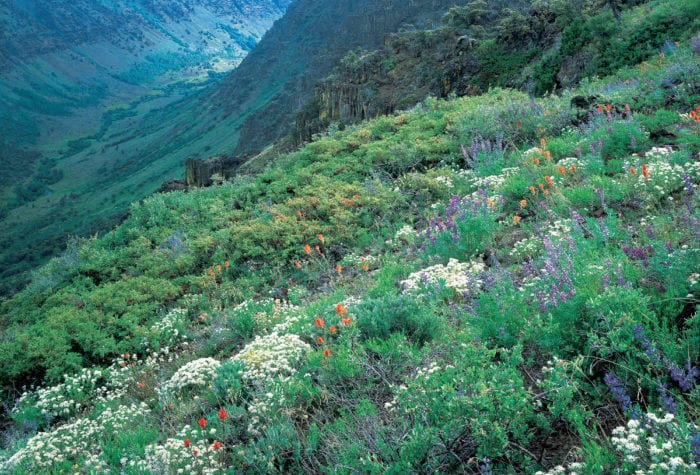Author: Jeremy Austin | Published: July 13, 2021 | Category: In the News
Each morning, as Google populates my inbox with news stories from across the Sagebrush Sea, one word increasingly dominates the headlines: wildfire.
“Firefighters working to contain 2 wildfires after significant overnight growth”
“Wildfires: Bigger, hotter than ever. How will the land recover?”
“How should the US prepare for another intense wildfire season?”
Entering another fire season, the West is once again on edge: fire, smoke, and the loss of life, property and habitat.
As I write this, more than 90 percent of the West is currently classified as being in a drought, with most areas experiencing “extreme” to “exceptional drought,” the two highest measured categories. The U.S. Drought Monitor reports our current conditions to be the most expansive and intense drought the western United States has experienced in the past century. For Oregon, the “conditions are among the driest going back to 1895.”
Governor Brown has already declared a drought emergency for 22 of the 36 Oregon counties. Even areas that are generally considered as “wet” are parched. Between March and May, the gauge at the Portland Airport collected just 2.5 inches of rain; “normal” precipitation for that time period is over 9 inches.
Oregon’s high desert – and principally the south-central and southeast regions – has been hit especially hard by current conditions, recording the lowest total precipitation relative to the average of anywhere in the state. Lake Abert, a critical stopover for migratory birds traveling along the Pacific Flyway, is essentially devoid of water. Desert rivers, such as the John Day, have been reduced to surprisingly low flows, with potential effects on resident and migratory fish species. Perhaps no other place has drought been more visible than the Klamath Basin, where tough decisions and tense debates are reminiscent of the early 2000s.
And of course there has been the heat. All-time record setting temperatures have blanketed the Northwest, with temps climbing as high as 117 degrees Fahrenheit in Oregon. Most of the state’s snowpack has already melted, and it did so – you guessed it – at a historic rate, making for a summer water supply forecast that is below average for almost every watershed in Oregon.
This all feeds into what’s anticipated to be yet another above average fire year, in a decade that boasts the two largest on record. Last year just over a million acres burned in Oregon – the second most on record – resulting in the tragic loss of life, habitat and more than 4,000 homes. Just a few years back, in 2012, 1.3 million acres burned – the largest year on record – a million acres of which were important habitat for the imperiled greater sage-grouse in southeastern Oregon.
Confounding this issue is the fact that some amount of fire is both natural and necessary to native communities. Most ecosystems in Oregon evolved to depend on fire for a host of important ecological benefits it provides. However, in Oregon’s high desert, the presence of invasive grass species like “cheatgrass,” in combination with climate change and the loss of native species, has fundamentally transformed the balanced fire ecology that Mother Nature intended for this landscape.
So, how are we supposed to manage for this complex, seemingly impossible issue? And where do we start?
At the national level, President Biden has renewed emphasis on addressing the climate crisis, biodiversity protection, science-based decision-making, and landscape-scale conservation. This includes initiatives such as 30 by 30, which focuses on conserving and restoring 30 percent of the country’s lands and waters by the year 2030. Science-based changes to how we manage large landscapes will be absolutely essential to ensuring we retain and rebuild healthy and resilient native ecosystems that are capable of robust recovery following fire.
The president also recently announced important support for our firefighters on the frontlines, with a much-needed increase in minimum pay and assurances to continue their employment for longer periods, keeping these responders on the job.
Closer to home, the Oregon legislature just passed what may be the first ever omnibus wildfire bill, including important funding for Rural Fire Protection Associations and installation of more remote fire cameras – measures ONDA advocated for. These are critical infrastructure for the sagebrush steppe that can help detect fires early and provide for quick suppression to keep fires small.
In the end, successfully addressing the challenges facing the arid West, its people, lands, waters, and wildlife, will require sound leadership at all levels. Some of the ongoing work at both the national and local level appears to be on the right track. Scale and delivery of planning, management and resources will be key to conserving, restoring and building resiliency in fire-managed landscapes, and to responding to unnatural fires when they occur. Finally, we can’t be afraid to be bold and consider unconventional approaches and propose new, innovative, science-based management as humankind and our environment adjusts to a warmer, drier west.
